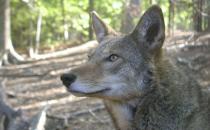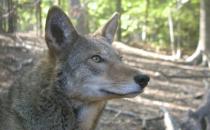Court victory: Wild red wolves get another chance at survival
Today a court in North Carolina ruled that federal officials violated legal requirements to protect and recover the world’s last wild red wolves. The ruling came in our challenge to the U.S. Fish and Wildlife Service’s actions authorizing the capturing and killing of non-problem wolves and abandoning conservation measures that had been used for decades.
Following an October hearing, the U.S. District Court for the Eastern District of North Carolina issued an order declaring the Fish and Wildlife Service violated the Endangered Species Act and the National Environmental Policy Act in its management changes.
Examining the agency’s decisions to simultaneously allow private landowners to shoot and kill non-problem red wolves, to end releases of red wolves, and to end active management of coyotes, the court found that “taken together, these actions go beyond the agency’s discretion and operate to violate [the U.S. Fish and Wildlife Service’s] mandate to recover this species in the wild.”
The court also made permanent its 2016 order stopping the Fish and Wildlife Service from capturing and killing, and authorizing private landowners to capture and kill wild red wolves.
For four years now, the U.S. Fish and Wildlife Service has been dismantling one of the most successful predator reintroductions in U.S. history,” said Senior Attorney Sierra Weaver. “The service knows how to protect and recover the red wolf in the wild, but it stopped listening to its scientists and started listening to bureaucrats instead. The law doesn’t allow the agency to just walk away from species conservation, like it did here.
SELC brought the federal court action on behalf of Defenders of Wildlife, the Animal Welfare Institute and the Red Wolf Coalition over the Fish and Wildlife Service’s decision to allow red wolves that were not causing any problems to be shot and killed by private landowners. This occurred at the same time as the agency rolled back conservation measures that had helped red wolves grow from four pairs released in 1987, to over 100 animals in eastern North Carolina from 2002-2014. Since those management changes were made, the red wolf population has plummeted over the past four years to as few as 24 known red wolves in the wild today.
The Fish and Wildlife Service attempted to avoid a ruling in this lawsuit by proposing a new rule in June to restrict wild red wolves to one National Wildlife Refuge and a bombing range in eastern North Carolina. The proposed rule would allow the immediate killing of any wolves that live on or wander onto non-federal lands in what previously had been a designated 1.7 million acre five-county Red Wolf Recovery Area.
The proposal would reduce the recovery area by almost 90 percent, eliminating protections for endangered red wolves from 1.5 million acres. In 2016, a group of 30 scientists condemned such a scenario because the limited area could not support a viable population of red wolves and was inconsistent with the best available science. Conservation groups opposed this proposal, arguing instead for an alternative that would reinstate previous successful management measures.
According to the conservation groups, 99.9 percent of the 108,124 comments that the agency received on its proposed rule supported red wolf recovery in the wild. Only 19 comments—with 13 of these coming from a single real estate developer—supported USFWS’s proposal to restrict red wolves to only federal lands in Dare County.
The red wolf recovery program served as a model for reintroduction efforts and was widely celebrated as a success for 25 years before the service began ending its successful conservation actions. Once common throughout the Southeast, intensive predator control programs and loss of habitat drove the red wolf to extinction in the wild in the late 1970s. Later, red wolves bred in captivity were reintroduced on a North Carolina peninsula within their native range in the late 1980s.
Read more about the ruling from


